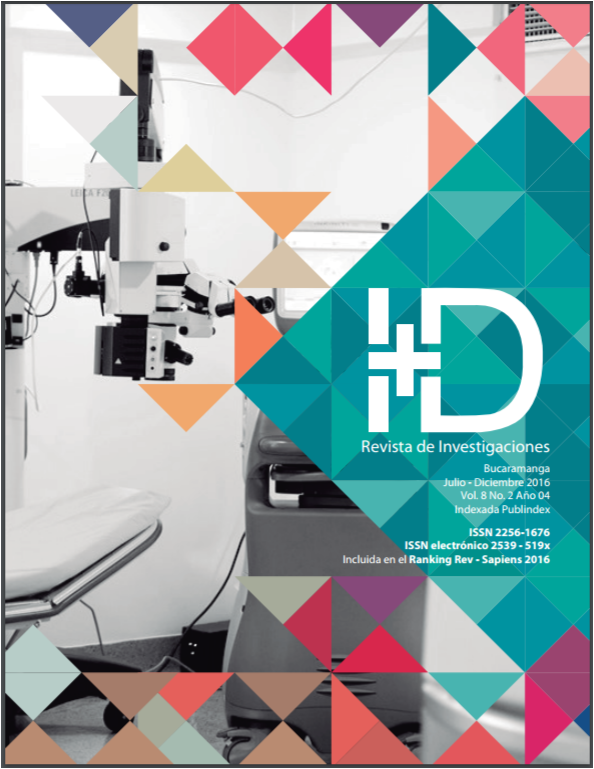Application of Discrete choice models for prioritize and select users of operating rooms
DOI:
https://doi.org/10.33304/revinv.v08n2-2016006Keywords:
Patient prioritization, Latent variable models, Discret choice models, Logit function, Rasch modelAbstract
This paper explores a quantitative methodology based on a probability distribution Logit to establish priorities in the selection of patients accumulated waiting in lists for surgery services in the Health services institutions. A set of associated factors at the surgical intervention results was evaluated, such effect of the interaction between the patient’s pathology and the IPS operative skills, for to estimate the achieved impact in the improve of the patient’s quality life through an index in interval scale. This way of prioritizing overcomes the limitations of the results of traditional instruments for measuring the variable, through a more efficient selection model.Downloads
References
Alemi, F. & Gustafson, D. ( 2010). Decision Analysis for Healthcare Managers. Chicago : Health Administration Press.
Anderson, D. & Sweeney, D. (2009). Estadística para administración y Economía. México: ECengage Learning.
Apella, I. (2009). Estimación de la función de demanda de salud. El caso Argentino. Nuevos documentos CEDESD., 59, 16-19.
Asua, J. & Taboada, J (2005). Experiencias e instrumentos de priorización. Red de investigación de resultados en salud y servicios sanitarios (IRYSS), 2-3.
Bond, T. & Fox, C. (2001). Applying the Rasch Model : Fundamental Measurement in the Human Sciences. New Jersey: Lawrence Erlbaum Associates, Inc.
Briones, G. (2008). Métodos y Técnicas de investigación para las ciencias sociales. México: Trillas.
Cardoen, B. (2010). Operating room planning and scheduling: A literatura review. European Journal of Operational research 201(3), 921-932.
Cohen, L. (1979). Approximate Expressions for Parameter Estimates in the Rasch Model. The British Journal of Mathematical and Statistical Psychology, 32, 113-120.
Corporacion IBM (2016, 03 25). IBM Software SPSS. Retrieved from IBM Software SPSS: Recuperado de http://www-01.ibm.com/software/co/analytics/spss//
De la Garza, J., Morales, B. & González, B. (2013). Análisis estadístico Multivariante. México: Mc Graw Hill.
Derret, S., Devlin, N. (2003). Prioritizing patients for elective surgery: a prospective study of clinical priority assessment criteria in New Zeland. Int J of Technology Assess Health Care, 91-105.
Edwards, R. (1997). NHS Waiting Lists: Towards the elusive solution. London : Ofce of Healths Economics .
Espallargues, M., Gallo, P. & Sampietro, L. (2000). Situación y abordaje de las listas de espera en Europa. Agència d’Avaluacióde Tecnologia i Recerca Mèdiques, Departament de Sanitat i Seguretat Social. Barcelona: Generalitat de Catalunya.
Habermann, S. (1977). Maximum Likelihood estimates in exponencial response models. The annals of statistics, 5(8), 15-841.
Hair, A., & Tatham, B. (2001). Análisis multivariante (5a ed México: Prentice Hall.
Hauch, K. & Smith, P. (2004). The economics of priority setting for health care: a literatura review. Washington, DC (US): The world Bank.
Kenneth, E. (2009). Discrete Choice Methods with Simulation (2.a ed.). Cambridge: Cambridge.
Kerlinger, F. & Lee, H. (2002). Investigación del Comportamiento (4.a ed.). México: McGraw Hill.
Liao, T. (1994). Interpreting Probability models Logit, probit and other generalized linear models. Illinois: SAGE publications, Series on Quantitative Applications in the social sciences.
Linacre & Wright, (s.f.). A User´s Guide to BIGSTEPS Rasch
Model Computer Program Recuperado de://www.winsteps.com/a/bigsteps.pdf
Ministerio de la Protección Social. (2008). Precios y Contratos en salud, Estudio indicativo de precios y análisis cualitativo de contratos. Bogotá: Colección PARS.
Ministerio de Salud. (2015, 06, 01ListadodeIndicadoresdeIPS.aspx http://calidadensalud.minsalud.gov.co/IndicadoresdeCalidad/ListadodeIndicadores/
Montgomery, R. (1995). Probabilidad y Estadística Aplicadas a la Ingeniería. México: Limusa.
Ortún, V., Pinto, J., & Puig-Junoy J. (2001). El establecimiento de prioridades. Atención Primaria, 673-6.
Oudhoff, J., & Rimmermans, D. (2007). Waiting for elective general surgery:Impact on health related quality of life and psychosocial consequences. BMC Public Health, 164-174.
Pride, W. (2015). Foundations of Marketing. Stanford: Cengage learning.
Rasch, G. (1981). Probabilistic models for some Intelligence and attainment Test. Chicago: University of Chicago.
Sabik, L., & Lie, R. (2008). Priority setting in health care: Lessons from the experiences of eight countries. Equity Health, 1-13.
Sallenave, J. (1994). La gerencia integral. Bogotá: Norma.
Sánchez, F. & Abellán, J. (2008). Cómo se deben establecer y evaluar las prioridades en salud y en servicios de salud? Métodos de priorización y disparidades regionales. Informe SESPAS, 22 (Supl 1), 126-36.
Taha, H. (2008). Investigación de Operaciones. México: Pearson.
Thorndike, R. (1989). Psicometría Aplicada. p. 127. México: Limusa.
Tristán, A. (2001). Análisis de Rasch para todos México: Ed Ceneval.
Wright, B. (1977). Solving measurement problems with the Rasch model. Journal of education nmeasurement, 14 , 97-116.
Wright, B. & Douglas, G. (1976). A Rasch ítems analysis by
hand. Research memorándum N° 21 Statistical Laboratory.
Department of education University of chicago, 1-6.
Wright, B. & Mead, R. (1975). Sample-free calibration with
a Rasch measurement model. Research memorandum N°
Statistical Laboratory: Department of education University of chicago, 1-6.












